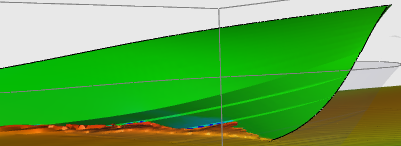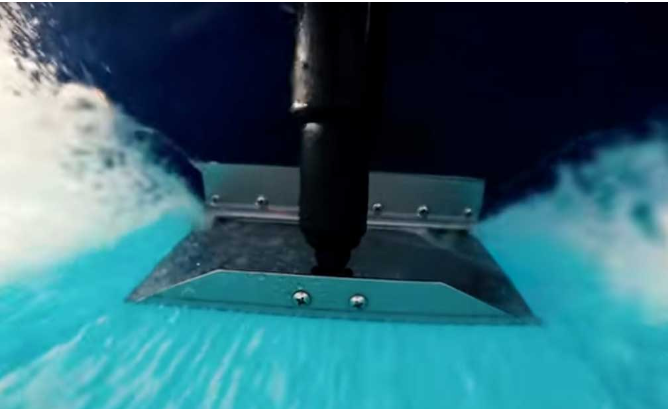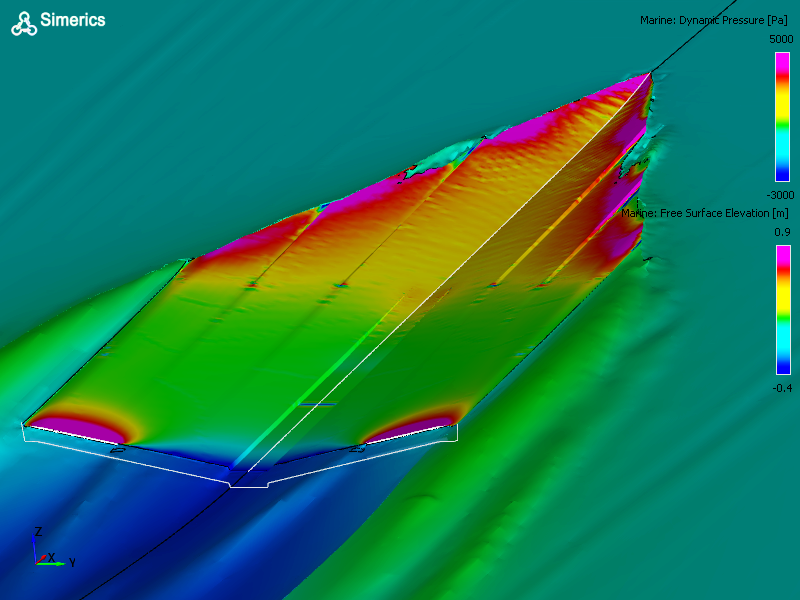The Catch CROSSOVER 27 Hull:
Inshore Shallow & Offshore Comfortable
Advancements in Spray Analysis for Enhanced Passenger Comfort
Drawing inspiration from naval engineering research around the world, particularly the groundbreaking work on spray rails at Tallinn University of Technology, Estonia in 2022, our team embarked on developing customized spray rails for the Catch CROSSOVER 27 hull.
Utilizing state-of-the-art computer simulations, we were able to build upon existing research, refining our design to:
- Enhance Hydrodynamic Efficiency: By optimizing the shape and placement of spray rails, we effectively managed the water spray, reducing drag and enhancing the vessel’s speed and fuel efficiency.
- Reduced G-Forces: Our simulations allowed us to analyze how different rail configurations impacted the G-forces experienced by the vessel, leading to a design that minimized sudden impacts from waves, thereby improving ride comfort.
- Minimize Spray: Strategic placement and design of spray rails resulted in less water spray on the deck, contributing to overall comfort and safety.
In mid-size center console fishing vessels, the standard configuration often includes 12-inch by 12-inch trim tabs
Interceptors: A New Wave in Design
Interceptors, vertical blades that serve as an alternative to traditional trim tabs, are increasingly favored due to their innovative approach.
Several Naval universities have conducted studies on interceptor blades, highlighting their effectiveness and advocating wider blades for more stern coverage.
However, there’s a noticeable gap in research directly comparing interceptors with trim tabs or exploring optimal trim tab dimensions. Motivated by this, we undertook our own Computational Fluid Dynamics (CFD) analysis.
Our findings reveal a pervasive trend in the boat manufacturing sector of copying industry peers without questioning foundational design choices.
Underwater Dynamics with Interceptors
We observed the Catch CROSSOVER 27’s hull dynamics, showcasing pressure distributions with and without interceptors:
- No Interceptors: Displays the typical pressure gradient from high at the bow to low or negative at the stern.
- Interceptors Deployed: Lowering interceptors just 1/8th of an inch significantly alters this dynamic, transforming the stern’s negative pressure into positive, aiding in leveling the boat. This adjustment enhances efficiency and reduces the required horsepower.
Our tests, corroborated by university research, confirm that wider interceptor blades are preferable to maximize positive pressure conversion at the stern.
Trim Tabs: Revisiting Conventional Wisdom
Turning our focus to traditional trim tabs, we analyzed the conventional 12-inch by 12-inch models:
- Effectiveness of Width: Like interceptors, wider tabs mitigate negative pressure across the stern more effectively.
- Optimal Length: Our simulations revealed a pressure gradient across the tab itself, suggesting that shorter tabs, ideally no longer than 6 inches, could outperform longer ones by avoiding the negative pressure zone at the trailing edge.
Trim tabs partially down
Conclusion: The insights from our simulations advocate for a reevaluation of trim tab design, promoting wider and shorter configurations for optimal performance. This approach not only aligns with the physics of hull dynamics but also promises improved efficiency in vessel performance. Based on this research, the Catch CROSSOVER 27 hull was specifically designed for interceptors or trim tabs up to 24 inches wide.
A Stepped Hull Design Was Not Optimal for The Catch 27
The beauty of crafting a boat from scratch lies in the freedom from constraints, allowing for thorough consideration of all options to select the most suitable design. While exploring various possibilities for the Catch CROSSOVER 27, we deliberated extensively on incorporating a stepped hull design but ultimately concluded a stepped hull design was not the optimal choice for our application.
Stepped hulls have witnessed a surge in popularity over the past decade, yet their origins trace back much further. In 1872, Englishman Rev. Ramus pioneered the concept, which gained traction in the early 1900s with the rise of more powerful gasoline engines. Over the last three decades, significant advancements by astute engineers have further refined this technology.
The primary allure of a stepped hull lies in its ability to reduce the wetted surface area of the hull in contact with the water, consequently diminishing drag.
This phenomenon occurs as negative pressure forms behind the steps, drawing in air from the sides
As boat speed increases, more air is drawn in, resulting in less hull drag through the water.
Additionally, stepped hulls tend to ride flatter than their non-stepped counterparts, with pressure points on the bottom shifted aft, causing the stern to rise and the bow to lower, thereby reducing the angle of attack.
For certain vessels, such as large high-speed center consoles or offshore race boats characterized by their deep vee hulls, stepped designs offer distinct advantages.
However, for the Catch CROSSOVER 27 ( a mid-sized, mid-speed, shallow draft, family fishing boat) a stepped hull presents several disadvantages, even safety concerns, for the following reasons:
- Operational Speed: Stepped hulls require considerable speed to outperform non-stepped hulls efficiently. The negative pressure behind the steps induces drag, necessitating sufficient airflow beneath the hull to offset this drag. Research indicates that the efficiency threshold for stepped hulls typically begins around 40 mph, with some high-performance hulls requiring speeds upwards of 70 mph. However, the Catch CROSSOVER 27 is expected to operate within the speed range of 25 to 45 mph, wherein a stepped hull would either increase drag or offer negligible drag reduction.
- Risk of Spinouts: Stepped hulls, particularly on shallow draft vessels, can be prone to spinning out at high speeds. As speed increases, the aerated water passing under the hull can render the back end slippery, leading to loss of control and potential spinouts. Given the Catch CROSSOVER 27’s shallow draft of only 12 to 13 inches, the lack of substantial hull depth to grip the water would heighten the risk of high-speed spinouts with a stepped design.
- Limited Bow Control: Stepped hulls tend to maintain a flat ride on plane, even at lower speeds, with pressure points shifted aft. While this suits offshore race boats, it may pose challenges for a mid-size family fishing boat. Instances requiring the ability to raise the bow—such as navigating large boat wakes or rough inlets—could prove difficult with a stepped hull. To address this, we designed the CROSSOVER 27 hull to accommodate extra wide trim tabs or blade interceptors. This affords the captain the flexibility to adjust the pressures at the aft end of the hull, allowing for precise control over the running angle in various conditions. At the anticipated operating speeds of the CROSSOVER 27, properly sized trim tabs or interceptors enhance hull efficiency more effectively than a stepped design.



















